Learn how to make a perfectly buttery, flaky pie crust from scratch using this in-depth tutorial and video. This page includes all of my best success tips, lots of step-by-step photos, and a thoroughly detailed recipe. Millions of readers have been using this helpful guide since it was first published. Become a pro with this crust recipe and the rest will be as easy as… eating salted caramel apple pie!
I originally published this recipe in 2015 and have since added new photos, a video tutorial, and more success tips.
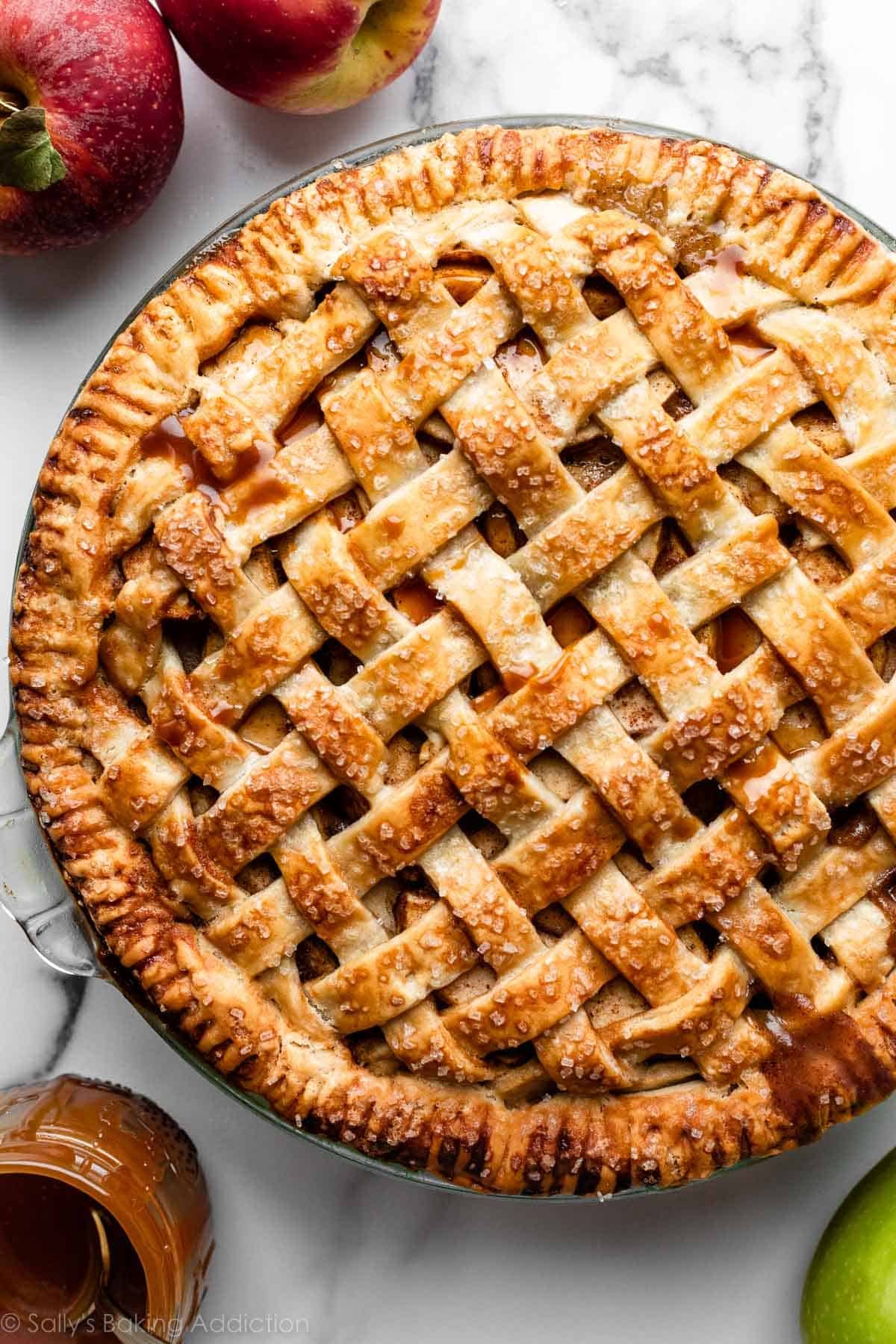
One reader, Laurie, commented: “Wow! I made a batch of my old favorite all-butter dough and a batch of this dough so I could have a ‘bake off’ to see which was better. This crust was fantastic: tender and very flaky. It will be my new standard crust! ★★★★★“
Another reader, Leo, commented: “This recipe was great! The dough was easy to make with the simple and detailed instructions from this recipe. I used it for my peach pie and it’s delicious! I also followed the braid and lattice tutorial and my pie looks great! ★★★★★“
For a baker, there’s nothing more satisfying than making a pie completely from scratch. Pies are often made for special occasions, and there’s a good reason for that: they’re time consuming. This shouldn’t scare you! It should intrigue you. If you’ve ever felt intimidated about making homemade pie crust, I’m here to walk you through it and cheer you on. If I can do this, you can do this.
Pie crust is the foundation for so many delicious desserts (plus savory pies and quiche), so once you build up your confidence in making a crust, you’re opening a door to an entire baking category. And that’s exciting! Whether your favorite pie filling is apple pie or creamy banana cream pie, or even eggs & cheese, the success of the overall pie can really hinge on the quality of the crust.
You wouldn’t hang a beautiful piece of art or favorite photo in a terrible frame, right?
Today I’m teaching you everything about making a buttery, flaky pie crust. This is my absolute favorite pie crust recipe and one of the most popular recipes on this website.
With all the recipe testing that goes into publishing the many pie recipes on this website and in my cookbooks, plus my annual Pie Week, it’s not an understatement to say that I have made a LOT of pies. Along the way, I’ve learned what works and what doesn’t, and I’m happy to share it all with you.
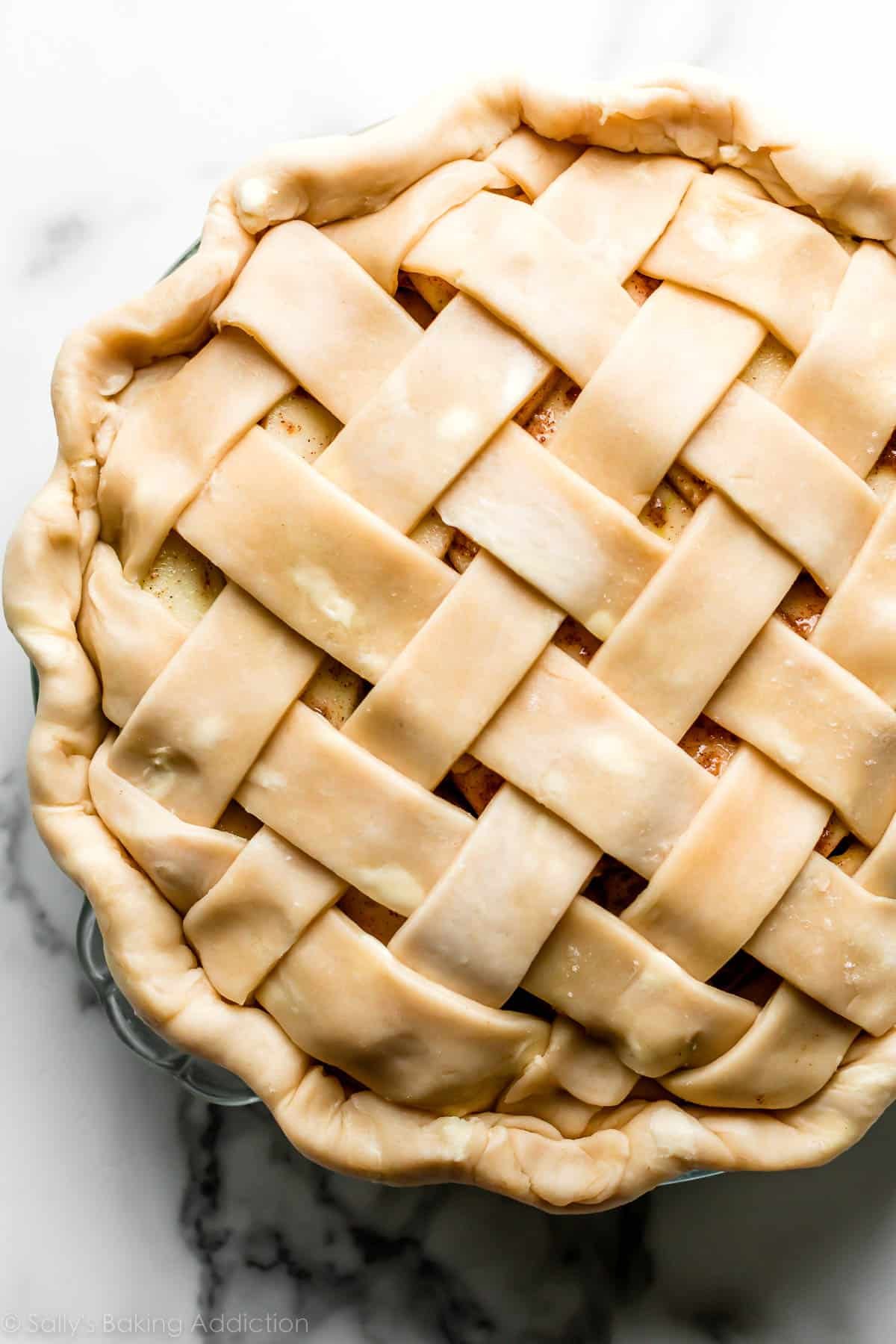
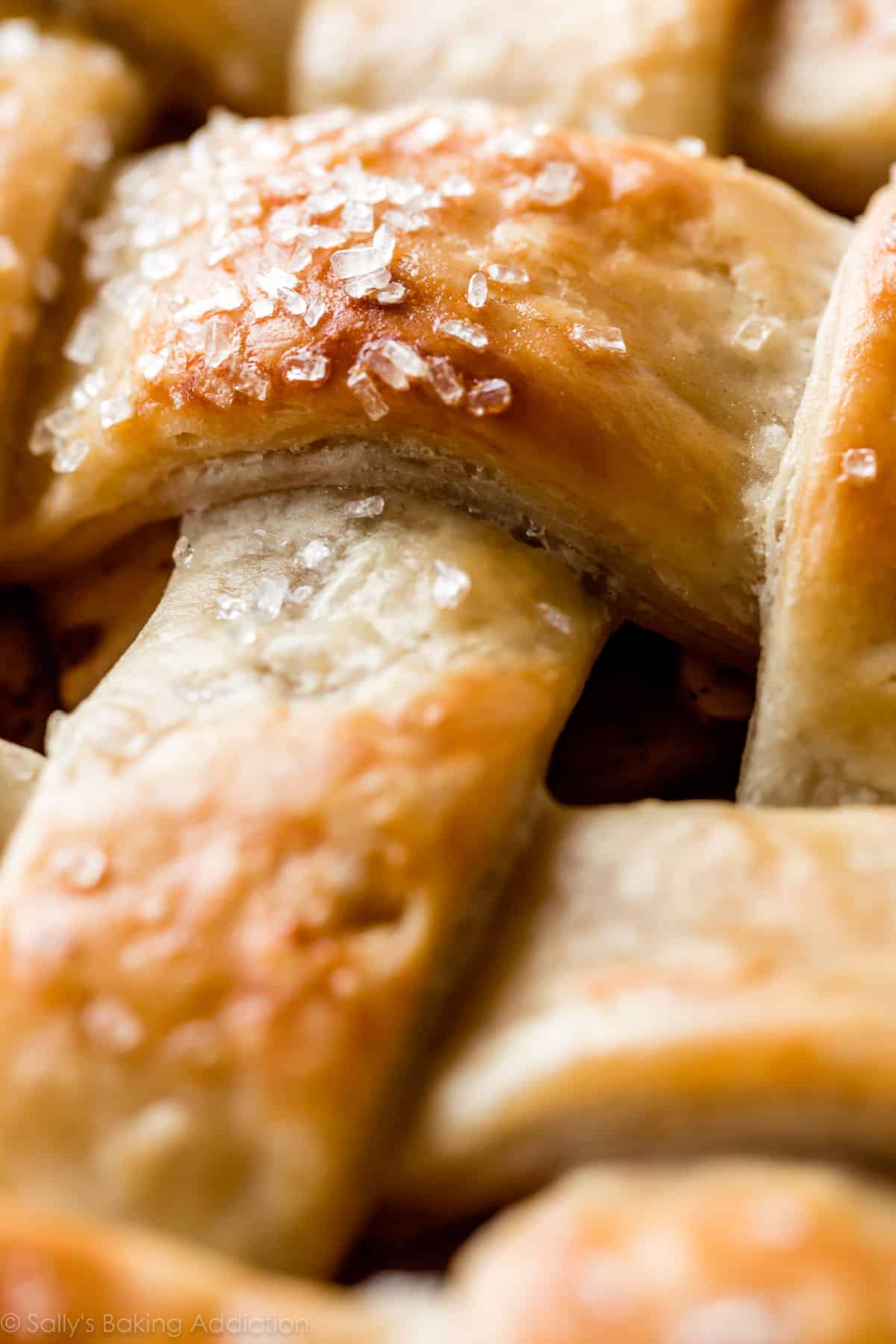
Start With These 5 Ingredients
The ingredient list for pie crust is short & simple:
- Flour: Start with quality flour. Did you know that not all all-purpose flours are equal? King Arthur Unbleached All-Purpose Flour is my go-to for not only pie crust, but for everything. (Not working with the brand, just a true fan!) Why? Its high protein level: “At 11.7% protein, it tops ordinary American all-purpose flours by nearly 2 percentage points.” What does this mean? Baked goods rise higher and stay fresh longer.
- Salt: Enhances the flavor.
- Butter: For that unparalleled buttery flavor and flaky layers.
- Vegetable Shortening: For structure and stability. More on this below.
- Ice water: Liquid brings the dough together. Some recipes call for half water and half vodka, because alcohol doesn’t promote gluten formation, which helps the crust stay flaky and tender. Basically, it’s a gift to anyone who accidentally overworks dough. If you want to try using vodka, use 1/4 cup (60ml) each cold vodka and cold water in this recipe.
You can use this pie dough for so many recipes beyond a traditional pie, too, such as mini pecan pies, mini fruit galettes, apple hand pies, and homemade brown sugar cinnamon pop tarts.
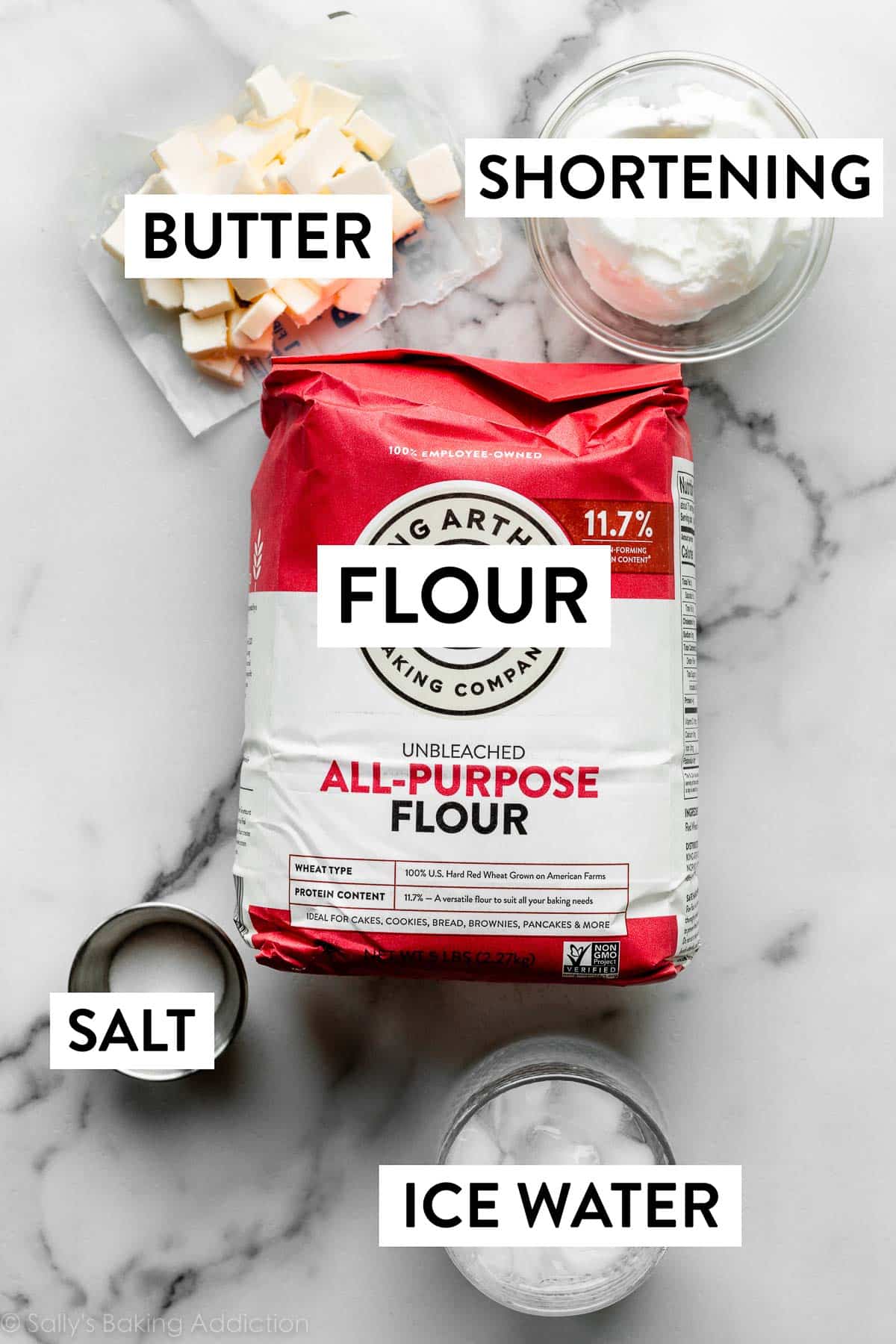
Is Pie Crust Better With Butter or Shortening?
I use BOTH shortening and butter in this pie crust because they work together to make the BEST crust. Buttery, flaky, and tender: the pie-fect trifecta.
- What does butter do? Butter adds flavor and flakiness.
- What does shortening do? Shortening helps the dough stay pliable, which is helpful when you’re rolling and shaping it. Plus, shortening’s high melting point helps the crust stay tender and maintain its shape as it bakes. Have you ever had a butter pie crust lose its shape completely? Shortening is “shape insurance.” 😉
If you don’t want to use shortening, try this all-butter pie crust instead. Let’s compare:
- Using all butter creates a lighter-textured crust and this is due to the butter’s water content. As the crust bakes, the butter’s water converts to steam, lifting up the dough and creating flaky layers. But because of all this butter, the crust doesn’t usually have a perfectly neat-edge/shape compared to the shortening and butter combination.
Both crusts taste buttery and flaky. But overall, this butter-and-shortening crust wins in terms of texture and flavor; AND, if you follow the pie crust recipe carefully, it holds shape too.
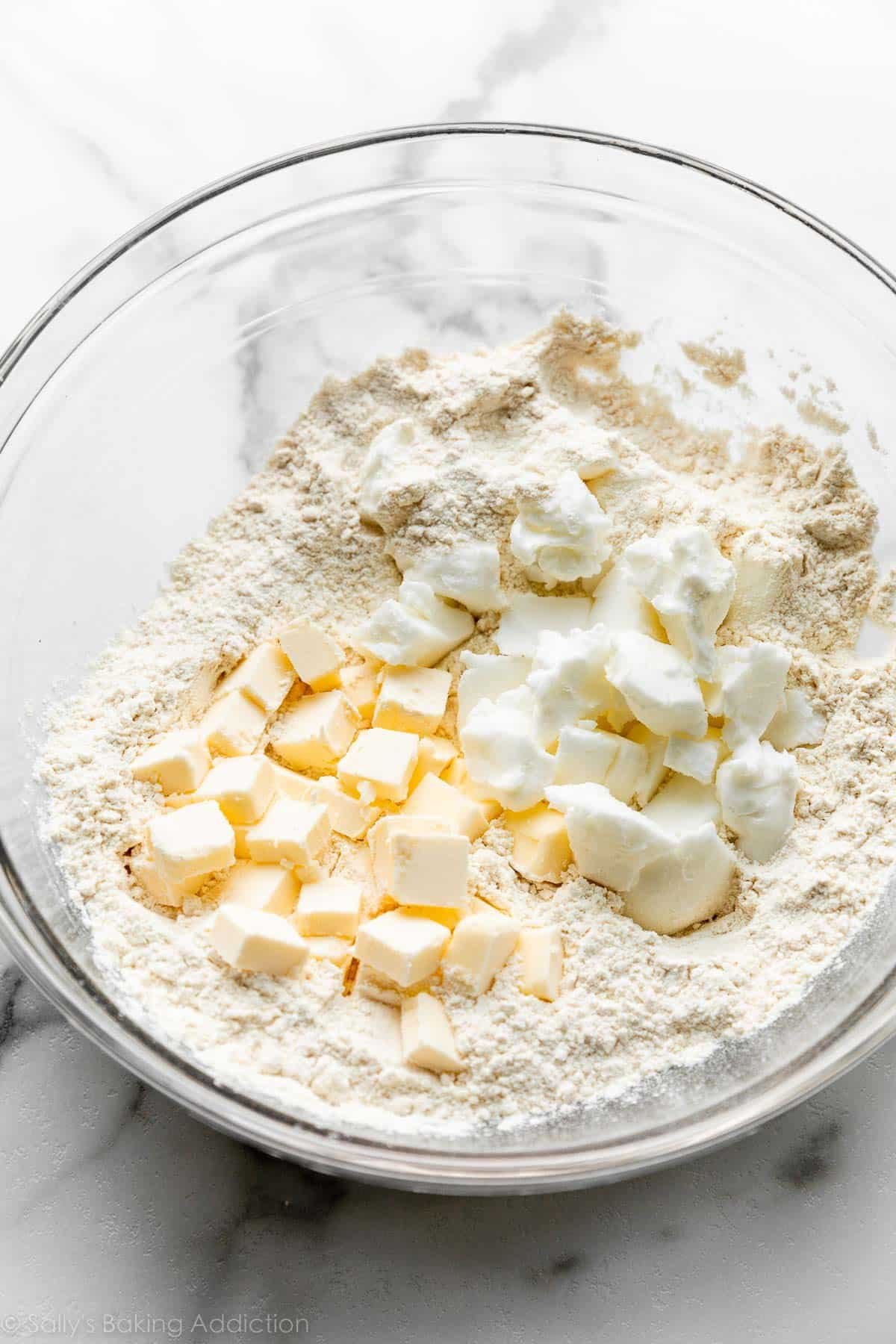
The Secret to Perfect Pie Crust: COLD
The refrigerator is as important as the oven when you’re making a homemade pie.
Why the emphasis on temperature? Keeping your pie dough as cold as possible helps prevent the fats from melting before the crust hits the hot oven. If the butter melts inside the dough before baking, you lose the flakiness. When the lumps of fat melt in the oven as the pie bakes, their steam helps to separate the crust into multiple flaky layers, as explained above. Warm fats will yield a hard, crunchy, greasy crust instead of a tender, flaky crust.
The colder the ingredients, the easier your pie crust is to work with, and the better it will turn out.
Two Tricks to Start as Cold as Possible:
- I keep some of my butter in the freezer and transfer it to the refrigerator a few hours before beginning the crust. This way it is still a little bit frozen and very, very cold. Simply keep the shortening in the refrigerator.
- Mix the dry ingredients together in a large bowl (the flour and salt). Place the bowl in the refrigerator or freezer while you get the rest of the ingredients ready.
These Step-By-Step Photos Will Help
Take the butter and shortening out of the refrigerator. Cube the cold butter and measure out the cold shortening. Give the shortening a little chop—this is actually optional because, truly, the shortening is quite soft even when cold so it’s easy to mix in.
Now it’s time to combine everything. Add the butter and shortening to the dry ingredients, and use a pastry cutter (or 2 forks) to cut in the fats. Some pie crust recipes use a food processor for this, but I don’t recommend it, because it can lead to overworking the fats into the dough, cutting them up too small—which means you’ll need less water and your dough will fall apart. In this step, you’re only breaking up the cold fat into tiny little flour-coated pieces; you’re not completely incorporating it:
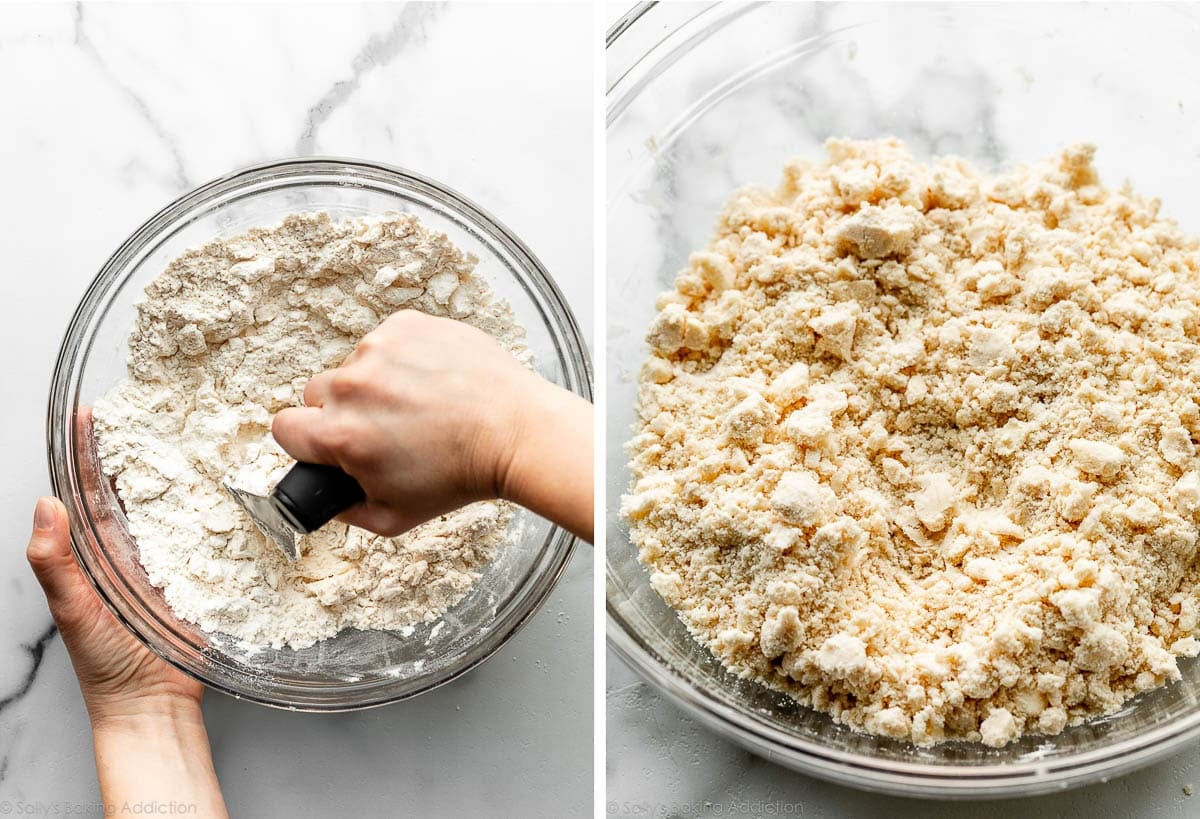
Cut in the fats until the mixture resembles coarse meal—crumbly with lots of lumps, as you see above. You should still have some larger pieces of butter and shortening when you’re done.
From a cup of ice water, measure out 1/2 cup (120ml), since the ice has melted a bit. Drizzle the cold water into the dough 1 Tablespoon (15ml) at a time, stirring after every Tablespoon has been added.
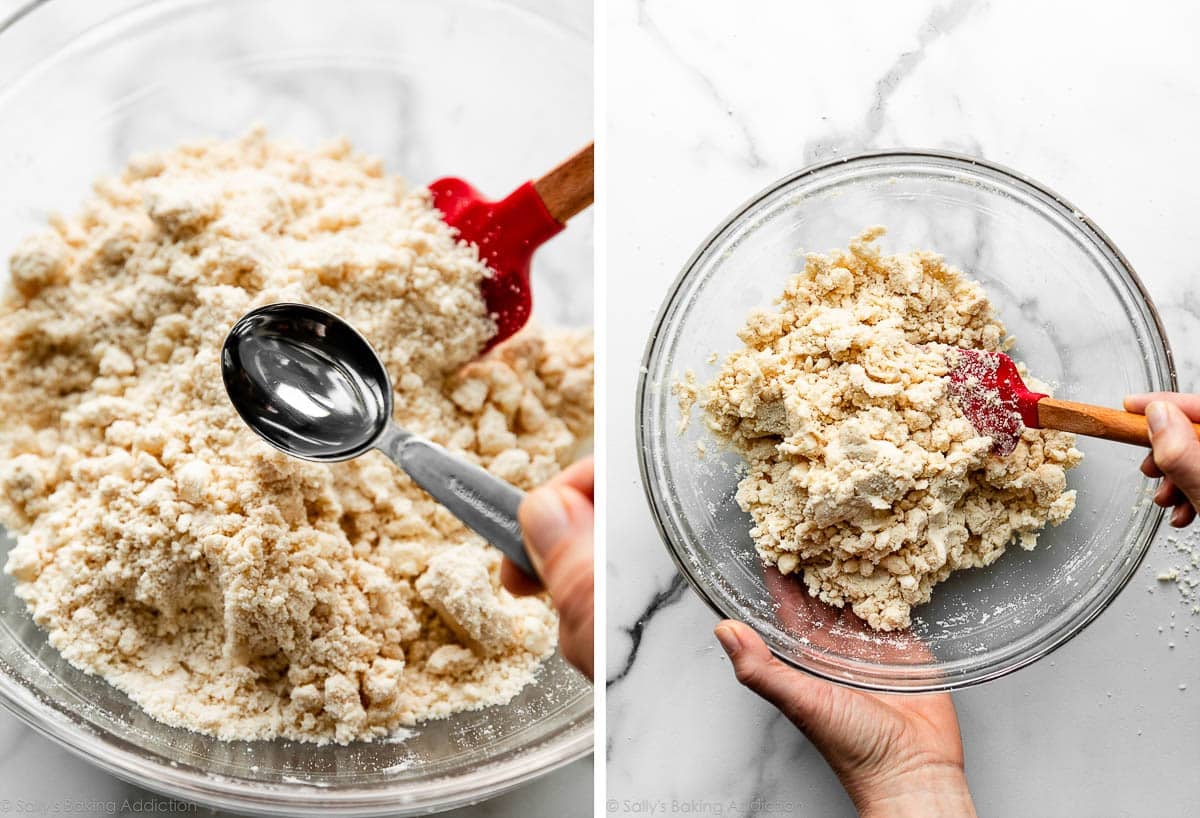
You’ll add just a little water at a time so that you don’t accidentally add too much. Stop adding water when the dough begins to form large clumps. I usually use 1/2 cup (120ml) of water, but if the weather is humid, you may not need as much, and if the weather is really dry, you may need a little more.
If too much water is added, the pie dough will require more flour and become tough.
If too little water is added, you’ll notice the dough is dry and crumbly when you try to roll it out and handle it.
You want the dough to clump together, but not feel overly sticky. Once the dough is clumping together, transfer the dough to a floured work surface.
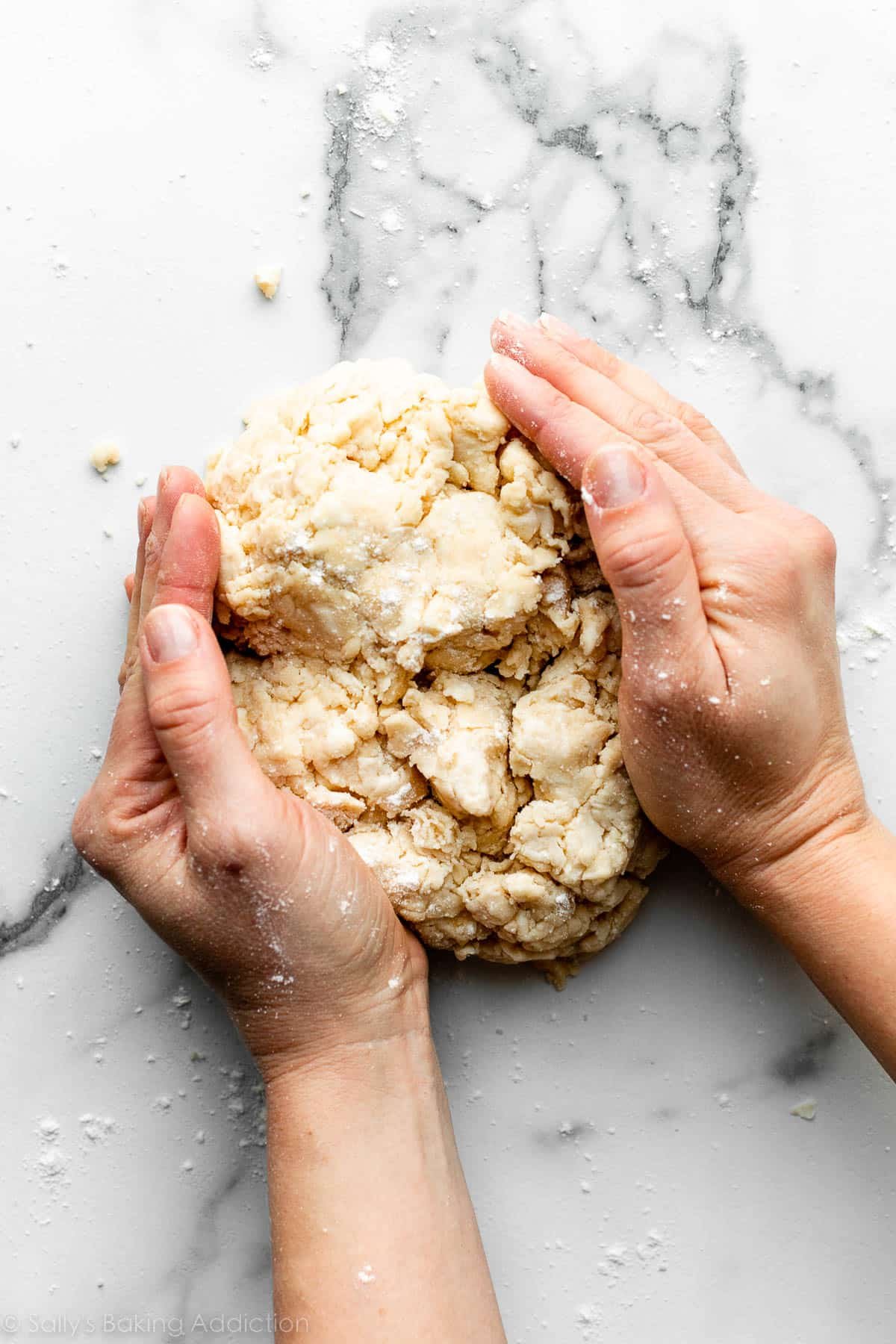
Using floured hands, fold and smush (yes, that’s the technical term) the dough into itself, forming the dough into a ball. Your hands are your best tool, just like when making homemade puff pastry.
The ball of dough should come together easily. If it feels a bit too dry or crumbly, dip your fingers in the ice water and then continue forming the dough with your hands. If it feels too sticky, sprinkle on more flour and then continue forming the dough with your hands.
Once your ball of pie dough has come together, use a sharp knife to cut it in half:
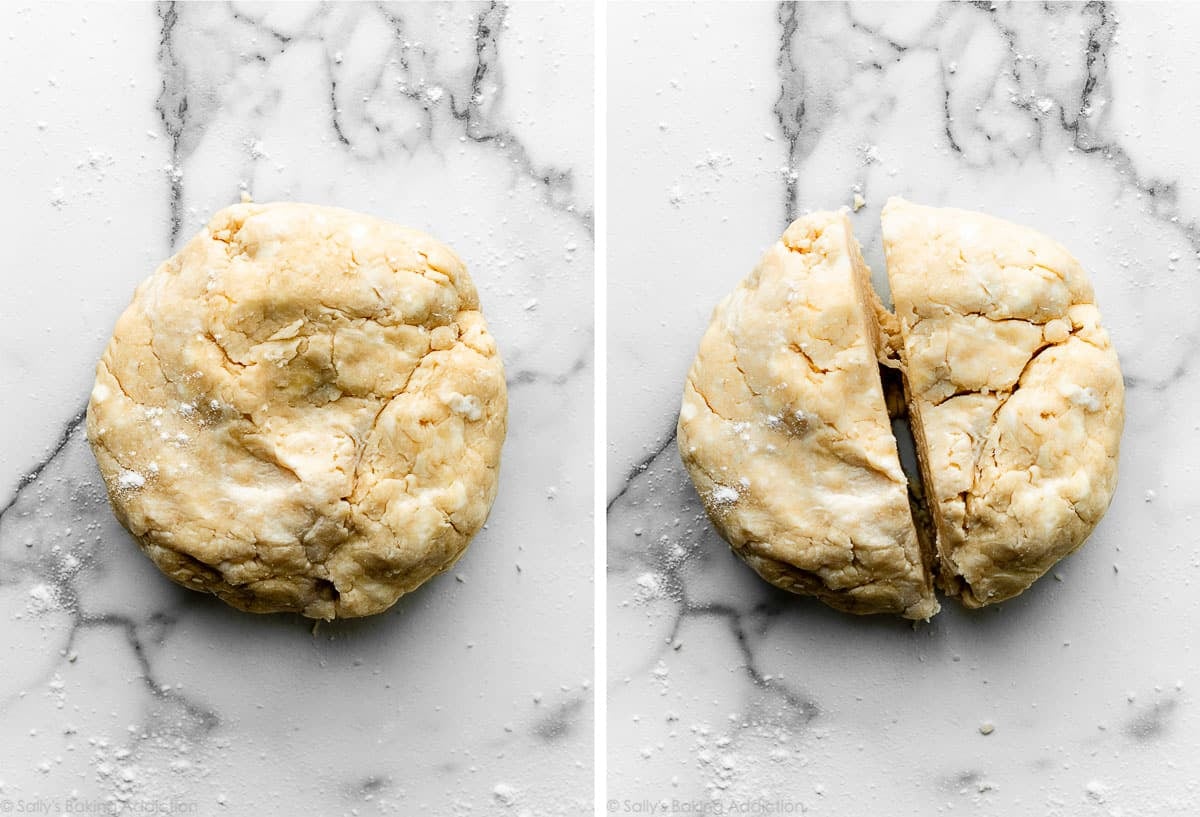
This is enough dough for 2 pie crusts. You can use both crusts for a double-crust pie, like chicken pot pie and strawberry rhubarb pie; or, if your pie doesn’t require a top crust, like coconut cream pie, brownie pie, and lemon meringue pie, save the second pie crust for another pie. You can also roll out the second dough and use cookie cutters to make an easy pie design, like on this pumpkin pie.
Success Tip: Visible Specks and Swirls of Fat in Pie Dough
Take a look at the inside of the dough where you just sliced it. You want to see pieces of butter and flaky layers throughout the pie dough. These specks and swirls of butter and shortening will help ensure a flaky pie dough. They are a GOOD thing!
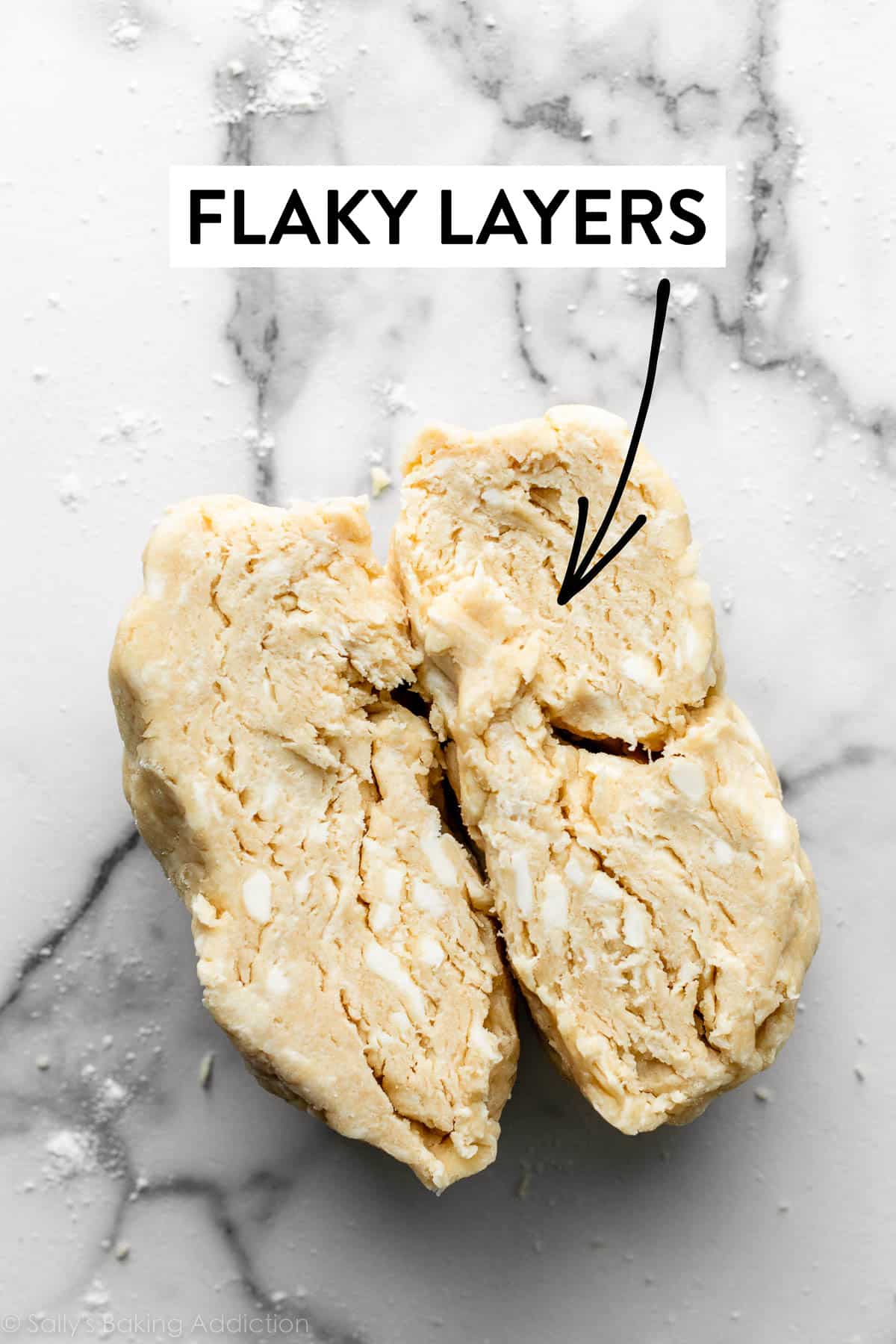
Now your pie dough is ready for a rest in the refrigerator. Flatten each half into 1-inch-thick discs using your hands. The disc shape makes it easier to roll out. Wrap each disc tightly in plastic wrap.
Refrigerate for at least 2 hours or up to 5 days.
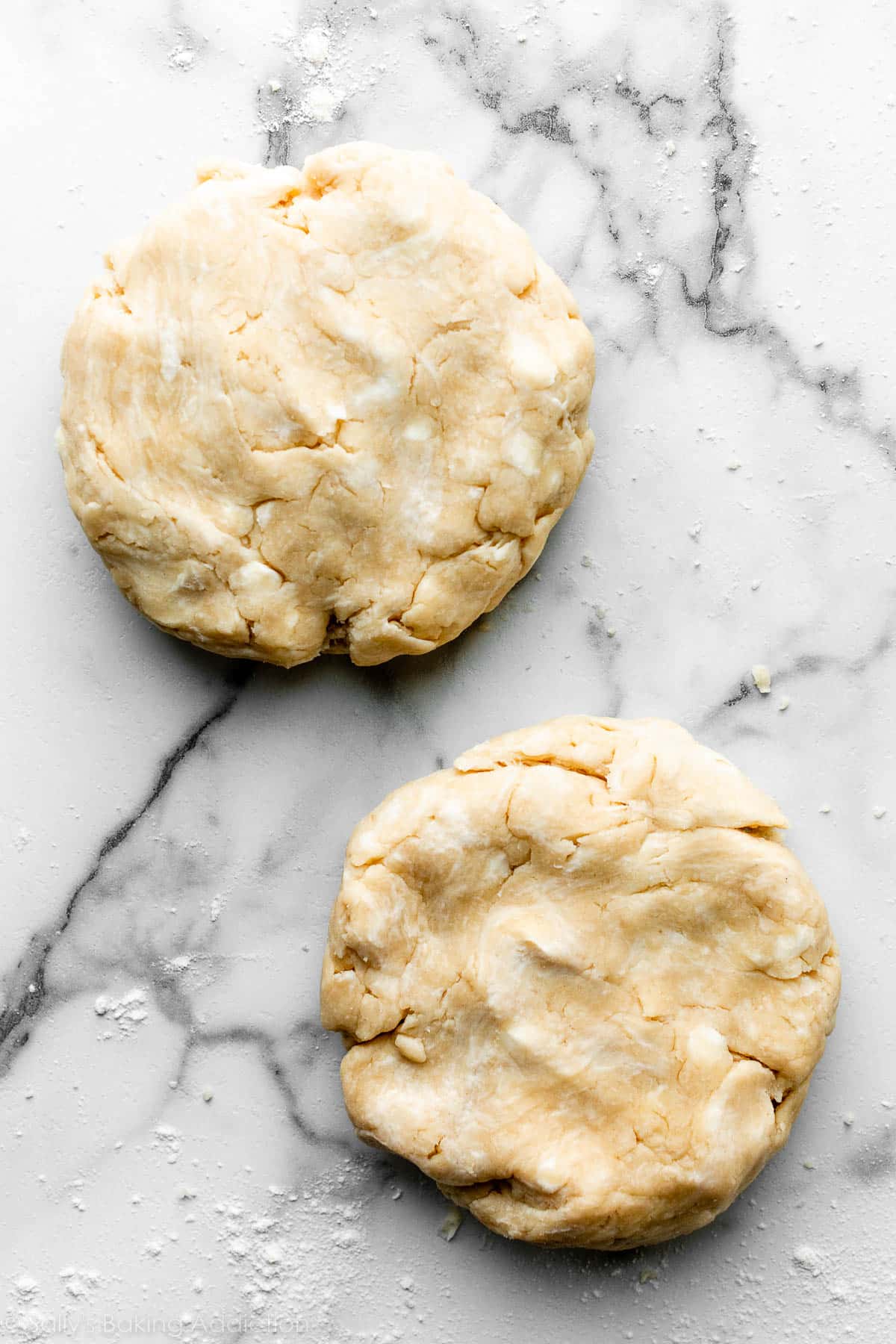
Can I Freeze Pie Dough?
Yes, absolutely, and I encourage it! Pie crust freezes beautifully, so it’s a great thing to make ahead of time. Store the tightly wrapped discs of pie dough in the freezer for up to 3 months.
If you know you’re going to want several pies around the holidays, or when your favorite fruit will be in season (cherry pie, anyone?), you can cut down on the amount of time it takes to make pies from scratch the day you want them by making several pie crusts in advance and freezing them.
Thaw the pie crust dough overnight in the refrigerator before rolling it out. It will be extra cold, which is a great starting point.
How to Roll Out Pie Crust
After the dough has chilled for at least 2 hours, you can roll it out. Work with one crust at a time, keeping the other in the refrigerator until you’re ready to roll it out. You’ll need a clean work surface, a rolling pin, and some flour. Lightly flour the work surface, rolling pin, and your hands, and sprinkle a little flour on top of the dough. Use gentle-medium force with your rolling pin on the dough—don’t press down too hard on the dough; you’re not mad at it!
When rolling dough out, start from the center and work your way out in all directions, turning the dough with your hands as you go:
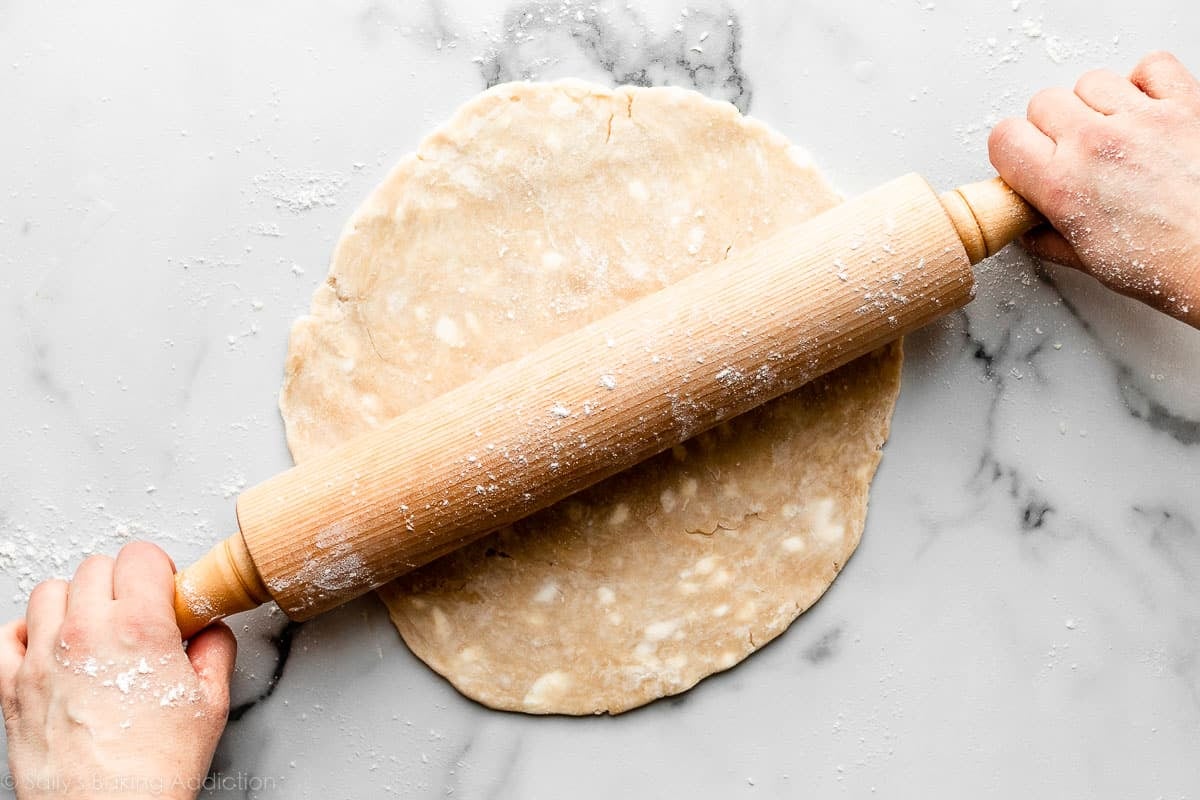
Between passes of the rolling pin, rotate the pie crust and even flip it, to make sure it’s not sticking to your work surface. Sprinkle on a little more flour if it’s sticking. Roll, turn. Roll, turn.
Do you see that beautiful marbling of the butter and shortening throughout the dough? Flaky layers, here you come!
Success Tip: If you notice the dough becoming a lopsided circle as you’re rolling it out, put down the rolling pin and use your hands to help mold the dough back into an even circle:
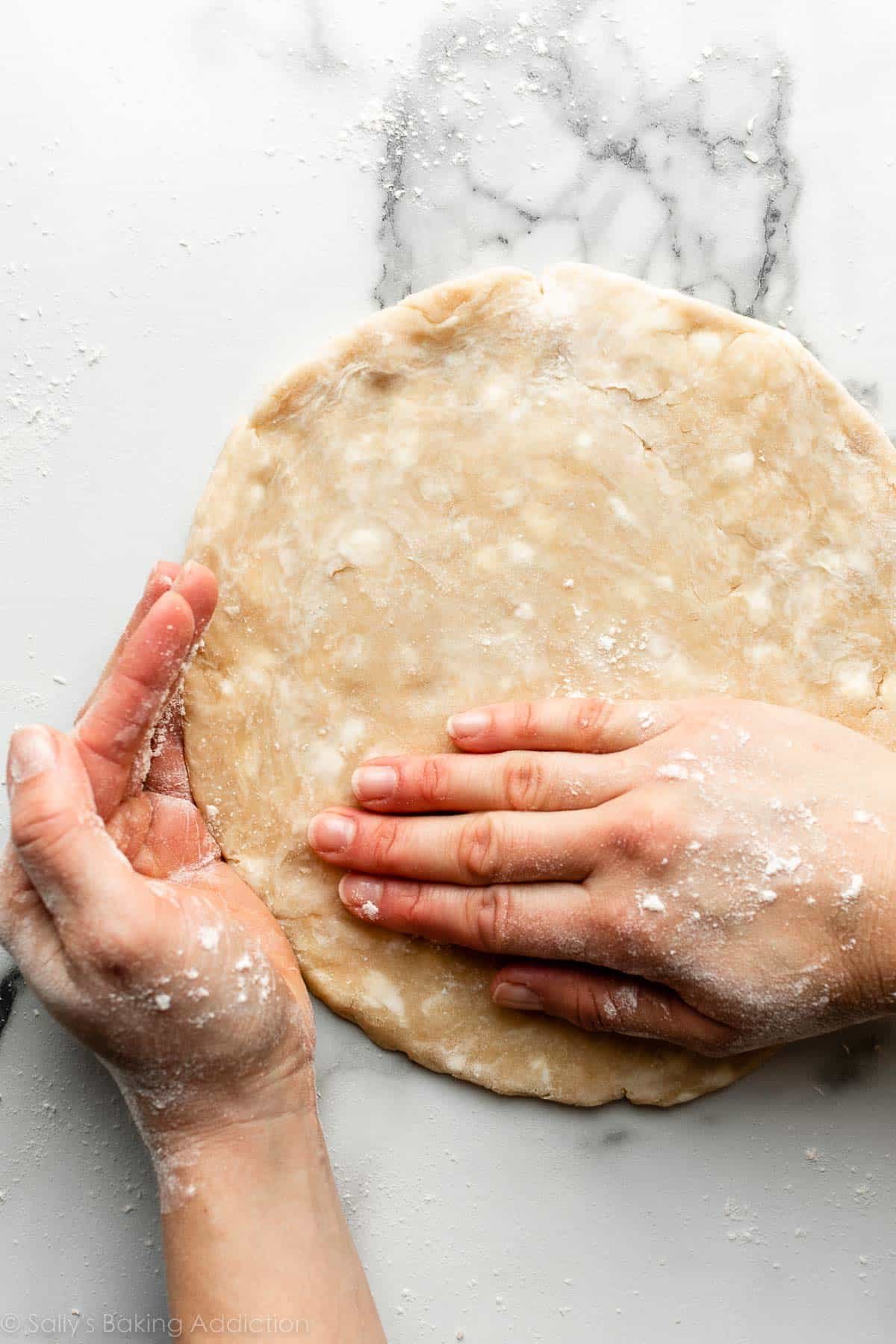
Roll the dough into a thin 12-inch circle, which is the perfect size to fit a 9-inch pie dish. You want enough crust to have some overhang so you can make a decorative edge for your pie.
Your pie dough will be about 1/8-inch thick, which is quite thin.
Success Tip: Since your dough is so thin, use your rolling pin to help transfer the pie crust to the pie dish. Carefully roll one end of the circle of dough gently onto the rolling pin, rolling it back towards you, slowly peeling it off the work surface as you go. Pick it up, and carefully roll it back out over the top of the pie dish. It’s helpful to watch how I do it in the video below.
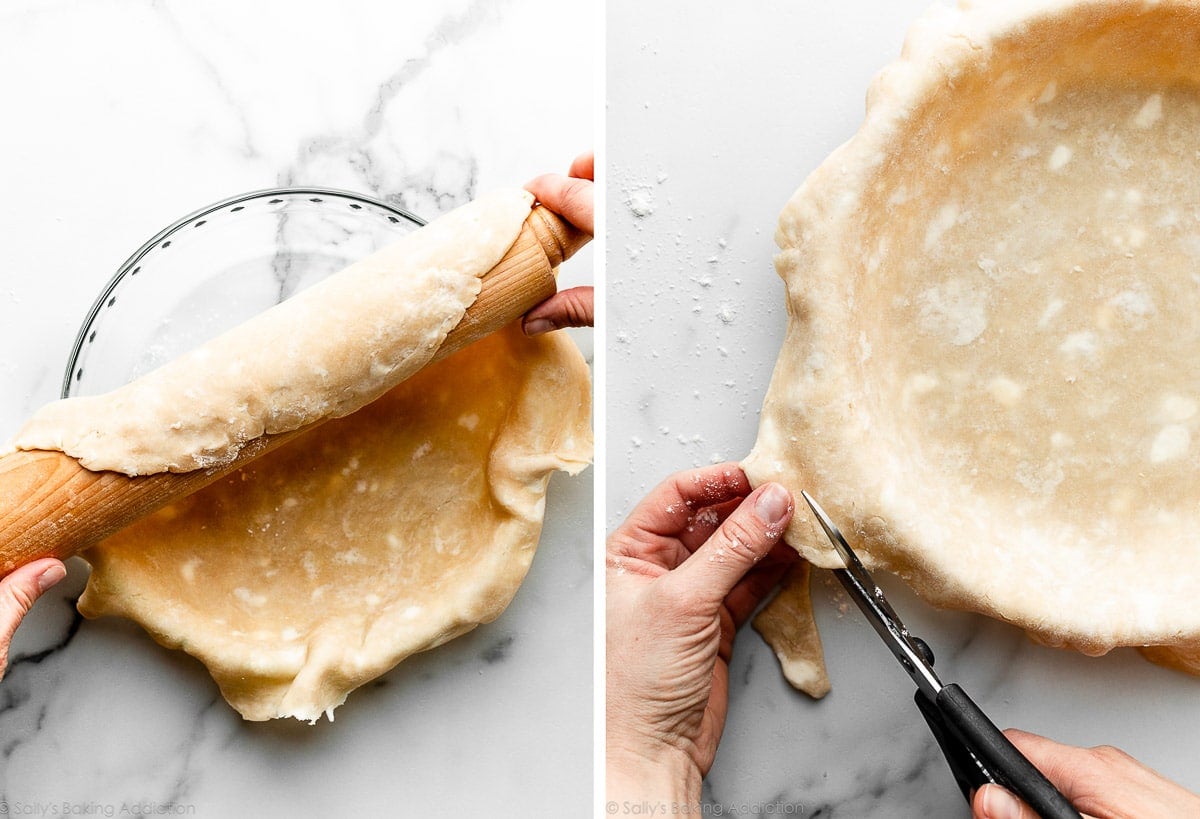
Make sure the pie crust is pretty well centered in the dish, with some overhang all around the sides. Tuck the crust into the pie dish, gently pressing it to the interior all the way around—no air bubbles.
Trim dough around the edges if there’s excess dough in some spots—you want about 1-inch overhang. After you add your pie filling and top crust (such as a lattice pie crust), fold overhang back over and pinch the top and bottom crusts together. Now you can create a pretty edge, such as fluting or crimping. I have a full tutorial on how to crimp and flute pie crust, but here’s a quick overview:
Fluting with fingers: To flute the edges, use a knuckle and 2 fingers to press around the edges of the pie crust, to give it a beautiful and classic scalloped look, like this apple pie.
Crimping with fork: You can also use a fork to crimp the edges, like I do with this peach pie.
Again, review my how to crimp and flute pie crust page and video if you need a little extra help with this step.
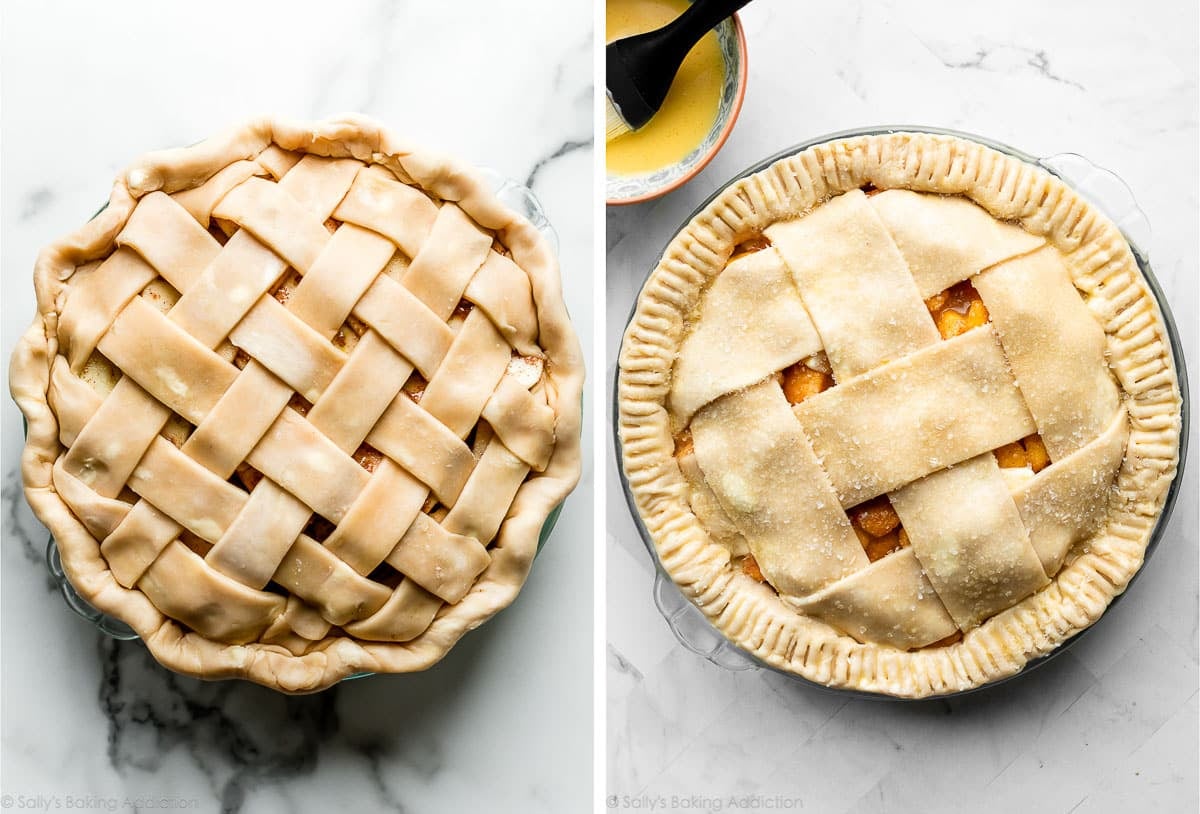
Your pie crust is ready to bake! Follow your pie recipe’s instructions from here; some recipes may call for a fully baked crust, and some may call for a partially baked (par-baked or blind baked) crust. You can read a tutorial on that here in this How to Par-Bake Pie Crust post. And some recipes, like this blueberry pie or triple berry pie, don’t require baking the crust at all before adding the filling, because the pie bakes for so long; just spoon/pour the filling right in.
Your pie recipe might call for an egg wash on the dough and for that, use a pastry brush. And if you bake a lot of pies, this list of 10 best pie baking tools will be helpful for you.
Troubleshooting Pie Crust
- Pie crust is tough: Tough crusts are the result of not enough fat in the crust, as well as overworking the dough. Use the recipe below (plenty of fat) and avoid handling the dough more than you need.
- Don’t have enough pie dough: This recipe yields 2 pie crusts. To ensure you have enough pie dough for overhang and a pretty topping, roll your dough out to a 12-inch circle, about 1/8 inch thick.
- Pie crust shrinks down the sides of the dish when baking: This can happen when par-baking a pie crust. See section below.
- Pie dough is dry & cracking around edges when rolling: Use enough ice water when preparing the pie dough. If you work the fats into the dry ingredients too much, the dough will feel too wet before you can add enough water. (And the dough will be dry and thirsty.) Do not overwork the fats in the dry ingredients—you still want those nice crumbles. If it’s too late and you notice the edges of your pie crust are cracking as you roll it out, dip your fingers in ice-cold water and meld the edges back together. Wait a minute, and then try rolling out again.
- Pie dough is falling apart & crumbling when rolling: The dough is likely crumbling because there’s too much fat, and not enough flour and water. Again, this is usually a result of fat being worked in too much, which can easily happen if the ingredients weren’t cold enough. (Refrigerate those dry ingredients before you start!) If it’s too late and the pie dough is crumbling as you roll it out, try adding more water AND more flour. Sprinkle a tiny bit of ice water and flour onto the cracks and crumbled pieces, and gently work it all in with your fingers. Wait a minute, and then try rolling out again.
Gently work ice water drops and flour into your crumbly pie dough to bring it back together:
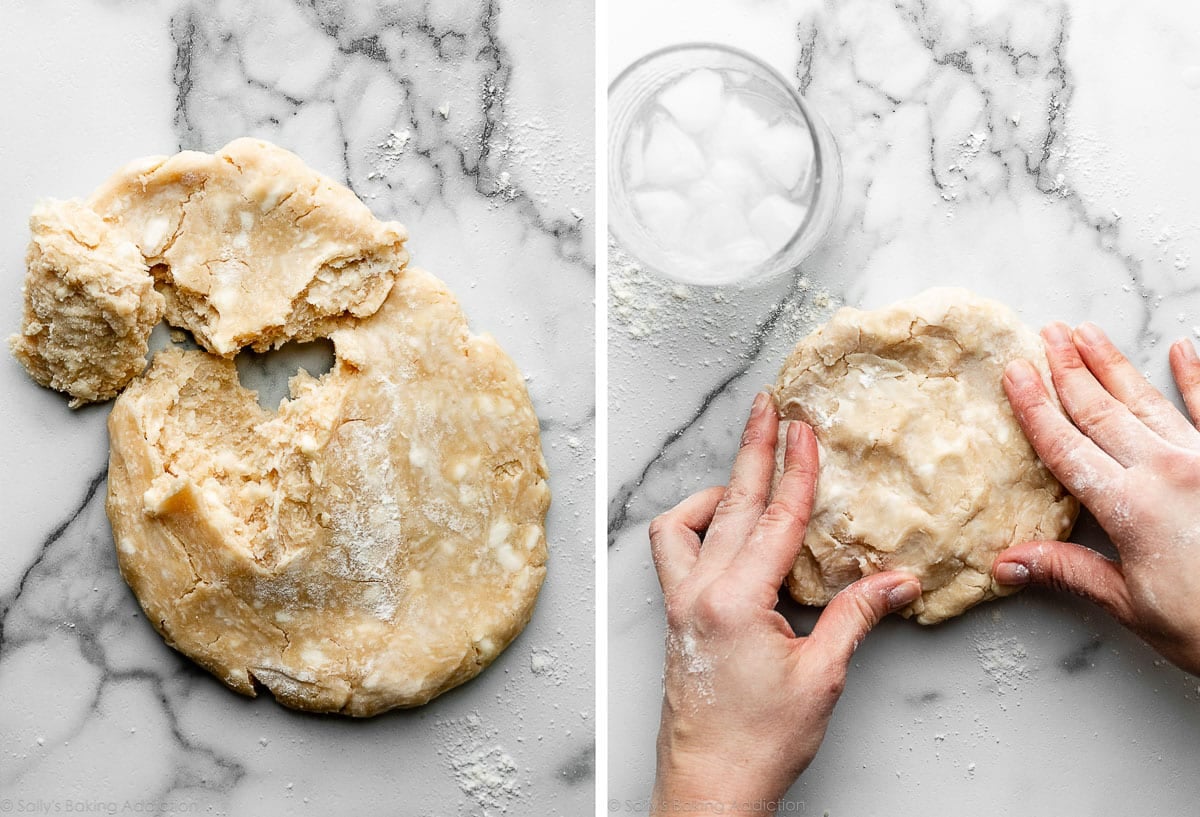
Blind Baking Pie Crust
If your pie recipe requires a fully baked or par-baked pie crust before adding the filling, follow the directions and success tips in this How to Par-Bake Pie Crust guide. You need 2 packs of pie weights, which are metal or ceramic beads that serve to weigh down the crust to prevent the puffing/shrinking. You could use dried beans instead. Whichever you choose, be sure to line the crust with parchment paper, then fill the empty pie crust shell with the weights prior to baking. Without pie weights, the dough will puff up, and then shrink down the sides.
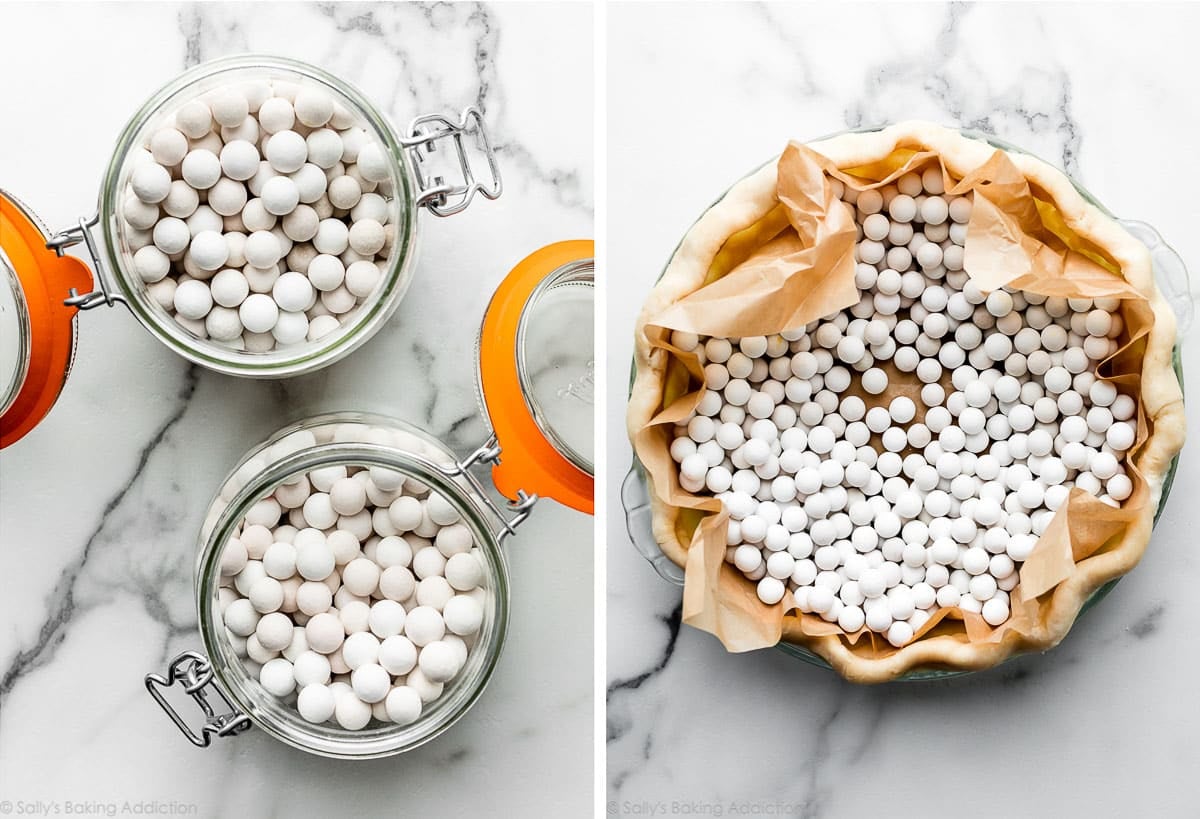
Pie Crust Success Tips
- Use a glass pie dish. I prefer using a glass pie dish when I make pie. Why? Glass dishes conduct heat evenly, which allows the bottom of the crust to bake thoroughly. Also, you’ll be able to see when the sides and bottom of the crust have browned.
- The refrigerator is pie dough’s best friend. Keep everything cold every step of the way: ingredients, the bowl, and the dough before rolling. When taking the pie crust out of the refrigerator to roll out and fill, make sure your pie filling is ready to go. If not, keep the pie crust in the refrigerator until it is.
- Keep dough cold when rolling out: Warm pie dough is unworkable. If the dough becomes too warm when you’re rolling it out, stop what you’re doing, pick it up as gently as you can, put it on a plate or small baking sheet, and then cover and refrigerate it for 10–20 minutes.
- Protect the crust edges from burning: Use a pie crust shield to prevent the edges from burning. A shield keeps the crust edge covered, but the center of the pie exposed, protecting the edges. I usually just make a pie shield out of a piece of aluminum foil. Take a piece of aluminum foil and fold it in half. Cut out a half circle. When you open it back up, you’ll have a square of foil with a circle cut out of the center. If you notice the edges of your pie crust are browning before the pie has fully baked, carefully and gently place the foil over the top of the pie, centering the cut-out hole over the pie. Carefully (obviously it’s very hot!) and lightly tuck the sides of the foil around the pie crust edges, then let the pie finish baking.
- Create a beautiful topping: For designing the top crust, see How to Lattice Pie Crust, How to Braid Pie Crust, or these Pie Crust Designs. And here is my tutorial on How to Crimp and Flute Pie Crust, too.
For more pie crust inspiration, see my graham cracker crust and homemade chocolate pop tarts (with a chocolate crust!).
Print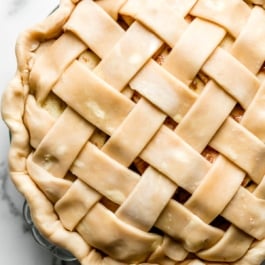
Homemade Buttery Flaky Pie Crust Recipe
- Prep Time: 15 minutes
- Cook Time: 0 minutes
- Total Time: 2 hours, 15 minutes
- Yield: 2 pie crusts (1 lb, 8 ounces dough total)
- Category: Pie
- Method: Baking
- Cuisine: American
Description
This recipe is enough for a double crust pie. If you only need 1 crust for your pie, freeze the other half per the Freezing Instructions below. Is your pie dough tearing, cracking, or crumbling as you try to roll it out? See recipe Notes.
Ingredients
- 2 and 1/2 cups (315g) all-purpose flour (spooned & leveled), plus more for shaping and rolling
- 1 teaspoon salt
- 6 Tablespoons (85g) unsalted butter, chilled and cubed
- 2/3 cup (130g) vegetable shortening, chilled
- 1/2 cup (120ml) ice cold water
Instructions
- Whisk the flour and salt together in a large bowl.
- Add the butter and shortening. Using a pastry cutter or two forks, cut the butter and shortening into the mixture until it resembles coarse meal (pea-sized bits with a few larger bits of fat is OK). In this step, you’re only breaking up the cold fat into tiny little flour-coated pieces; you’re not completely incorporating it. Do not overwork the ingredients.
- Measure 1/2 cup (120ml) of water in a cup. Add ice. Stir it around. From that, measure 1/2 cup (120ml) of water, since the ice has melted a bit. Drizzle the cold water in, 1 Tablespoon (15ml) at a time, and stir with a rubber spatula or wooden spoon after every Tablespoon has been added. Stop adding water when the dough begins to form large clumps. I always use about 1/2 cup of water, and need a little more in dry winter months. Do not add any more water than you need.
- Transfer the pie dough to a floured work surface. Using floured hands, fold the dough into itself until the flour is fully incorporated into the fats. The dough should come together easily and should not feel overly sticky. Avoid overworking the dough. If it feels a bit too dry or crumbly, dip your fingers in the ice water and then continue bringing dough together with your hands. If it feels too sticky, sprinkle on more flour and then continue bringing dough together with your hands. Form it into a ball. Use a sharp knife to cut it in half. If it’s helpful, you should have about 1 lb, 8 ounces dough total (about 680g). Gently flatten each half into 1-inch-thick discs using your hands.
- Wrap each tightly in plastic wrap. Refrigerate for at least 2 hours and up to 5 days.
- After the dough has chilled for at least 2 hours, you can roll it out. Work with one crust at a time, keeping the other in the refrigerator until you’re ready to roll it out. Lightly flour the work surface, rolling pin, and your hands, and sprinkle a little flour on top of the dough. Use gentle-medium force with your rolling pin on the dough—don’t press down too hard on the dough; you’re not mad at it! When rolling dough out, start from the center and work your way out in all directions, turning the dough with your hands as you go. Between passes of the rolling pin, rotate the pie crust and even flip it, to make sure it’s not sticking to your work surface. Sprinkle on a little more flour if it’s sticking; don’t be afraid to use a little more flour. If you notice the dough becoming a lopsided circle as you’re rolling it out, put down the rolling pin and use your hands to help mold the dough back into an even circle. Roll the dough into a very thin 12-inch circle, which is the perfect size to fit a 9-inch pie dish. Your pie dough will be about 1/8 inch thick, which is quite thin. Visible specks of butter and fat in the dough are perfectly normal and expected.
- Because your dough is so thin, use your rolling pin to help transfer the pie crust to the pie dish. Carefully roll one end of the circle of dough gently onto the rolling pin, rolling it back towards you, slowly peeling it off the work surface as you go. Pick it up, and carefully roll it back out over the top of the pie dish. It’s helpful to watch how I do it in the video below.
- Proceed with the pie per your recipe’s instructions. If your dough requires par-baking, see helpful How to Par-Bake Pie Crust tutorial.
Notes
- Make Ahead & Freezing Instructions: Prepare the pie dough through step 5 and freeze the discs for up to 3 months. Thaw overnight in the refrigerator before using in your pie recipe.
- Special Tools (affiliate links): Large Glass Mixing Bowl | Pastry Cutter | Rolling Pin | For more tools you may need to completely assemble and bake your pie, see my 10 Best Pie Baking Tools list.
- Salt: Use regular table salt. If using kosher salt, use 1 and 1/4 teaspoons.
- Shortening: This recipe uses a butter and shortening combination. Butter for flakiness and flavor, and shortening for its high melting point and ability to help the crust hold shape. You can use butter-flavor shortening if desired. If you want to skip the shortening, feel free to try this all-butter pie crust instead. Some readers have substituted lard for shortening in this recipe with success.
- Can I use a food processor? You can use a food processor to bring the dough ingredients together in step 1, but I find it quickly overworks the dough. For best results and a light, flaky crust, I recommend a pastry cutter.
- Pie dough is dry & cracking around edges when rolling: Use enough ice water when preparing the pie dough. If you work the fats into the dry ingredients too much, the dough will feel too wet before you can add enough water. (And the dough will be dry and thirsty.) Do not overwork the fats in the dry ingredients—you still want those nice crumbles. If it’s too late and you notice the edges of your pie crust are cracking as you roll it out, dip your fingers in ice-cold water and meld the edges back together. Wait a minute, and then try rolling out again.
- Pie dough is falling apart & crumbling when rolling: The dough is likely crumbling because there’s too much fat, and not enough flour and water. Again, this is usually a result of fat being worked in too much, which can easily happen if the ingredients weren’t cold enough. (Refrigerate those dry ingredients before you start!) If it’s too late and the pie dough is crumbling as you roll it out, try adding more water AND more flour. Sprinkle a tiny bit of ice water and flour onto the cracks and crumbled pieces, and gently work it all in with your fingers. Wait a minute, and then try rolling out again.
- More Crusts: If you need more than 2 pie crusts, make another separate batch of dough. Doubling or tripling the recipe leads to over- or under-working the dough, which ruins all of your efforts.





















This was my first time making pie, and I made sure to read the entire post and watched the video and all I can say was this couldn’t have been better explained to help someone make a pie crust. I loved all the photos, the expert tips, the video was also so well done. I had been purchasing pie crust for over a decade from being too scared of making a bad pie. I not only made an amazing pie crust, I had so much fun and had so much confidence doing it. My family loved the pie. It’s buttery, it’s flakey, it’s got the perfect crunch but still melts in your mouth. I am so happy to have found THE pie crust recipe of all pie crust recipes. I’ll be using this forever. On a personal note, it was a dream of mine to always make a pie when I had kids. My daughter is 16 months old and she got to help me, and it turned out better than I could have ever imagined. Sally, your pie crust recipe and guide was fantastic. Thank you so much!
Can I make the pie crust and bake it the same day
Mary, absolutely! After following steps 1-7, see step 8 – proceed with the pie per your recipe’s instructions. If your dough requires par-baking, see helpful How to Par-Bake Pie Crust tutorial. Happy baking!
Can you replace shortening with olive oil or something?
Hi Brilliant, olive oil will not work in this pie crust. Lard could replace the shortening, or you can try our all butter pie crust.
I only use King Arthur flour however the shortening…. I like to use Spectrum non hydrogenated but find it can be a nightmare for a double crust apple pie.
Have you ever used Spectrum shortening? I would really appreciate your thoughts on that as I always use healthy ingredients but also want a good result.
Hi Diane, we do use King Arthur flour, however we haven’t tried that brand of shortening. Let us know how it turns out if you do!
The very best! I used this recipe for a deep dish Turkey pot pie and it was amazing!! Thank you!
What do I do if I accidentally used salted butter and already cut and mixed everything!? I realized as I was putting the remaining butter away and now I am contemplating throwing it out and starting over please help!!
Hi Tiff, you can definitely still bake it, we wouldn’t throw it out. It will just be a little saltier. Perfect for a quiche!
I am always so happy with the results I get from all of your recipes, Sally. You never miss!
I have been a professional cook for over 25 years. I have a ton of my own recipes, but sometimes I get cook’s block, and defer to the recipes you have shared.
Whenever I look for a recipe or have an idea of something to make, I always ask myself “what would Sally do?”.
Thank you so much for sharing your talents with us all!
I have family members lactose intolerant.
May I use lactose free butter?
Hi Jacqueline, You can use all shortening but your pie crust will not be as flaky.
That’s what I decided to do! I’m freezing them to use for a more savory dish like quiche or chicken pot pie maybe!! Already made another batch of the pie crust (correctly this time haha!) and that will be used for your crumble apple pie recipe ❤️ Thank you! Not sure where my brain was because I’ve made this several times and never made this mistake in any recipe I’ve made.
Hi there and thank you for sharing your recipe 🙂
I am about to try your recipe for the dough and want to ask if I could add lemon juice (1 tbsp.) to it. If so, should I substitute one tbsp of water for 1 tbsp of lemon juice? what would you recommend?
Hi Irma, we haven’t tried it, but let us know how it turns out if you do!
When I was little, my Grandma June would always take pie crust scraps and make a sweet treat by spreading butter, sugar and cinnamon on them, and baking till the crust was done. So good! My grandkids now always expect me to make extra pie crust and for the crunchy sweet treat any time a pie is being made and this piecrust is awesome for this!
My grandmother did this as well! We are trying this recipe out today and maybe I will also make that for my kids.
Hands down the best pie crust recipe I’ve ever used. Thank you!
I am going to try this recipe this week. is it OK to use butter shortening instead of regular shortening?
Hi Andrew, yes, that will work!
I’d made this crust a few weeks ago for a single crust pie and froze the other half. I thawed it today and it rolled out beautifully. The first time I had a bit of difficulty with it as I was impatient and didn’t chill it quite long enough lol. It’s definitely something I’ll make ahead to have on hand in the freezer.
Sally, Can use lard instead of shortening in this recipe?
Hi Adrienne, some readers have reported success using lard in place of the shortening. Let us know if you try it!
If i am making chicken pot pie do i need to prebake the bottom pie crust?
Hi Ang, I usually don’t: chicken pot pie because I layer the gravy/sauce on top of the other filling ingredients
Can I make this in an aluminum pie tin? I would like to make pies for desserts, but not need to ask for me dishes back. What, if any, would the time/temperature differences?
Hi Kylie, you can absolutely use a disposable pie dish. Same temperature, but bake time may very a bit so keep a close eye on them.
This recipe has never failed me. It always holds its structure and never crumbles apart. I usually use the whole thing as one deep-dish pie crust! But as long as you wrap up your second dough disc really well in plastic and then bag it, it freezes well too. I don’t usually par-bake, but the bottom is usually a nice golden brown anyway. Also, if you’re in a hurry, don’t be shy about using the freezer! I wrapped this sucker up in plenty of plastic wrap and chilled it for 1 hour in the freezer (rather than 2 in the fridge), and it yielded the same results. Thanks, Sally!
What kind of pie do you make with this crust recipe? I see it says par-bake 10 min and then wrap edges with foil and bake more minutes. What do you do for baking time if not doing a par-bake? I am looking at Sally’s pumpkin pie recipe to try.
Hi Kylie, you can use this pie crust for any type of sweet or savory pie. It’s best to follow the baking directions from the specific pie recipe, as it will change depending on your recipe. See our pumpkin pie post for all the details!
May I make this gluten free by substituting a measure for measure type flour mix? Are there techniques or adjustments to be made for a successful pastry?
Hi Cathy, we haven’t tested this recipe with a gluten free 1:1 flour blend, so we’re unsure of the results. Let us know if you do give it a try!
This was awesome! First time making a pie and it turned out awesome! Only had 700g of apple to work with but for me, it was perfect!
Hi Sally, what brand of shortening do you think is best?
Hi Sandy, we often use Crisco shortening, but you can use any brand you prefer. Hope you enjoy this pie crust!
Thanks you a great recipe. I have made this three times, twice in the US with measuring cups and once in the UK with a scale following directions exactly. The UK version was much stickier and I think maybe 315g was not enough flour and only used 80-90 mls water. I also weighed the single ball and it was only 610g, not 680g. I’m sure it was 315g. As a comparative point I found my two US dough balls also were a bit small when rolled. Any ideas?
I am in Canada and prefer to use weight rather than volume measurements. But I have found the same problem with some of the recipes here (i.e scones) – the weight conversion for flour seems to be off. I’ve actually weighed out a cup of flour and it never equates to the volume measurement cited. Could it be difference in flours in various countries?? (I use stir, scoop and level method and am experienced baker.) Anyway, I now always use volume rather than weight on this site. Love the recipes here!
Hi Shirley, we’re happy to help! Different flours could be part of it, but it’s likely scooping the flour that’s creating the discrepancy. It’s best to spoon and level (rather than scoop), as scooping can pack in the flour. We always say that “A cup isn’t always a cup, but a gram or ounce is always a gram or ounce.” Basically, when in doubt go by the weight. Hope this helps!
Can I cut this recipe in half to make just one crust?
Hi Cara, absolutely. Or you can make the recipe as is and freeze the second crust for another time!
The all butter crust recipe you have has sugar in it, but this one doesn’t. Is this one less sweet? Should I add sugar?
Hi Marisa, we use this crust as written for sweet & savory pies, but you could add 1 Tablespoon of granulated sugar with the dry ingredients. Let us know if you give it a try!
I like to use my Kitchenaid for everything I can, so I tried it with this recipe and I think it worked just as well for me as using a pastry cutter. I froze the flour, salt, butter and shortening for 30 minutes, then put all into the mixer bowl with the whisk attachment. I wrapped a 30″ strip of foil around the top of the mixer bowl so nothing would fly out, and whisked it on medium-high for about 1 minute. The butter pieces where chopped into about pea size. I switched to the paddle beater and mixed on medium-low as I added the ice water, and it came together nicely with big chunks of butter just like in Sally’s photos. My crust turned out wonderful!
This is one of the best pie crust tutorials I’ve seen on the website. Congrats! Does this recipe work for a deep-dish pie? My problem with making pie dough is that I never seem to be able to roll out the crust big enough for a deep dish, with enough to hang over the edges.
Hi Christal, This makes enough dough for two 9-inch pie crusts. We often use this same crust in deep dish pans. However, you could always make 1.5x the recipe to ensure you have enough. Hope this helps!
This crust tastes AMAZING and was soooo flaky and good!! I tried it with a quarter cup of vodka in the ice water for that flakiness! I used Sally’s Apple Pie recipe (which is outstanding). The only issue I encountered was the bottom center of the pie crust disappeared while baking!! Flavor was still amazing so I don’t care that much if it happens again but I do want to make this pie for the holidays and would like to retain more crust. One thing I did differently from the recipe is I made the filling first and then pressed my pie dough into the pie pan, immediately filling and baking it. I didn’t think to refrigerate and get the pie crust cold again before filling. Is this possibly why it happened?
Hi Sarah, we’re so glad you enjoyed it! It does sound like your crust may have gotten a bit too warm, which caused it to melt in spots during baking. Making sure that the crust is extra cold before going into the oven is key, as well as making sure not to overwork the fats in the dough. Hope this helps for next time!
Recipe looks great! I’m from the UK so vegetable shortening isn’t widely available. Would I be able to substitute for lard? Or would you recommend just using butter?
Hi Emma, some readers have reported success using lard in place of the shortening. Let us know if you try it!
I’m a decent baker but I’ve never been able to manage a pie crust. I admit my go-to was the Trader Joe’s frozen brand but in their infinite wisdom they’ve decided to make that a seasonal item. So I found this recipe and having had good luck with your recipes before I thought I could master this. But I didn’t read it very carefully even though your instructions clearly say to read it carefully. So my first batch was too flaky and the fats got too melted. It was a disaster. So I tried again and followed everything as per the instructions and my pie crust actually turned out great! Will definitely use this recipe over and over!
I haven’t tried it but it’s almost identical to Julia Child’s recipe that I’ve used for 25 years.